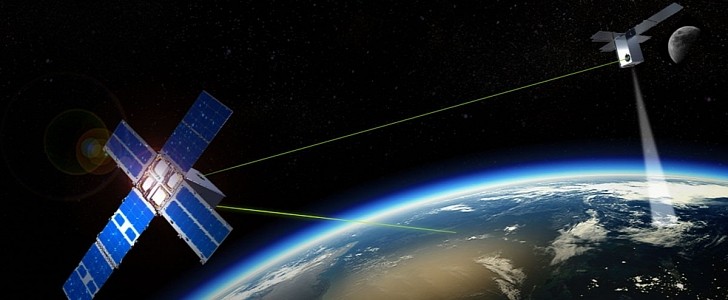On the Fourth of July weekend, while everyone was busy celebrating in the U.S., two tiny satellites started communicating with ground stations on Earth. Deployed by the Missile Defense Agency (MDA) on June 30th, these CubeSats are on their way to achieving communication between each other. Once proven successful, it could play a key role in U.S. missile defense technology.
The project, known as the CubeSat Networked Communications Experiment Block 1 (CNCE Block 1), focuses on demonstrating that networked radio communications are possible between nanosatellites, more specifically between CubeSats.
Nanosatellites are a type of satellite that measures four to eight inches in width and diameter, four to thirteen inches in length (10 cm × 10 cm × 10 cm). The standard CubeSat unit is known as 1U. A 1U CubeSat weighs no more than three pounds ( 1.33 kg).
CubeSat missions provide flexibility by allowing for follow-on flights with planned, incremental technical enhancements at a lower total cost than larger, traditional satellites. Building nanosatellites is also less expensive. By comparison, it takes around $1.3 million to construct a satellite, while a traditional one can go up to hundreds of millions.
The goal of these CubeSats is to detect missiles before they get to reach their target. MDA is currently working at a Hypersonic and Ballistic Tracking Space Sensor payload. Once deployed on satellites in low Earth orbit, it is designed to detect and track hypersonic and ballistic missile threats and send back data to both the Missile Defense System and the warfighter.
"The missile defense architecture will require communications between interceptors, sensors, and command and control systems to quickly identify, track and destroy incoming enemy missiles before they reach their targets. The CubeSats will allow the agency to demonstrate the capabilities quickly and affordably," said Walt Chai, MDA director for space sensors.
As part of a payload-sharing agreement with the U.S. Department of Defense Space Test Program, the CubeSats launched almost two weeks ago were carried into orbit aboard a VOX Space LLC, a subsidiary of Virgin Orbit, LauncherOne rocket from the Mojave Air and Space Port in California.
The CNCE Block 1 is the first of a planned series of tests. MDA will conduct a three-month demonstration, with a mission extension of up to one year in order to check if the two CubeSats can navigate properly, receive and transmit signals to radios and networks, and operate as intended.
Nanosatellites are a type of satellite that measures four to eight inches in width and diameter, four to thirteen inches in length (10 cm × 10 cm × 10 cm). The standard CubeSat unit is known as 1U. A 1U CubeSat weighs no more than three pounds ( 1.33 kg).
CubeSat missions provide flexibility by allowing for follow-on flights with planned, incremental technical enhancements at a lower total cost than larger, traditional satellites. Building nanosatellites is also less expensive. By comparison, it takes around $1.3 million to construct a satellite, while a traditional one can go up to hundreds of millions.
The goal of these CubeSats is to detect missiles before they get to reach their target. MDA is currently working at a Hypersonic and Ballistic Tracking Space Sensor payload. Once deployed on satellites in low Earth orbit, it is designed to detect and track hypersonic and ballistic missile threats and send back data to both the Missile Defense System and the warfighter.
"The missile defense architecture will require communications between interceptors, sensors, and command and control systems to quickly identify, track and destroy incoming enemy missiles before they reach their targets. The CubeSats will allow the agency to demonstrate the capabilities quickly and affordably," said Walt Chai, MDA director for space sensors.
As part of a payload-sharing agreement with the U.S. Department of Defense Space Test Program, the CubeSats launched almost two weeks ago were carried into orbit aboard a VOX Space LLC, a subsidiary of Virgin Orbit, LauncherOne rocket from the Mojave Air and Space Port in California.
The CNCE Block 1 is the first of a planned series of tests. MDA will conduct a three-month demonstration, with a mission extension of up to one year in order to check if the two CubeSats can navigate properly, receive and transmit signals to radios and networks, and operate as intended.

